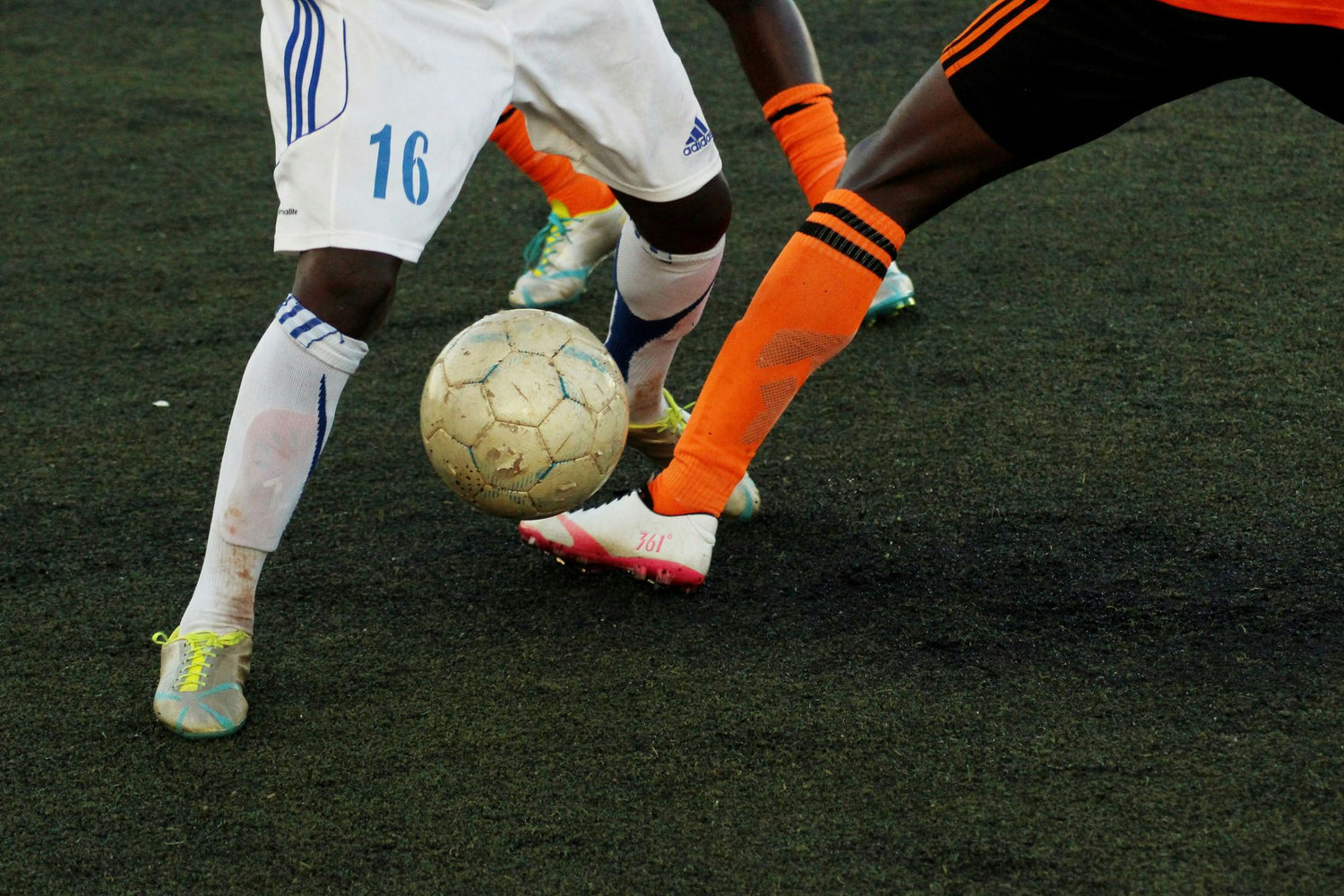Implementing FIFA 11+ and Nordic curls into youth soccer training can significantly prevent injuries, particularly hamstring issues that frequently sideline young players. In this blog, we take a look at the practical application of FIFA 11+ and Nordic curls for youth injury prevention, presenting robust findings and guidelines that coaches, players, and parents can employ for safer play. Plus, we will discuss the importance of incorporating these strategies into training routines.
Key Takeaways
-
The FIFA 11+ program is a structured warm-up routine designed to prevent common soccer injuries, including hamstring injuries. When performed consistently, it has been proven to substantially reduce injury risk.
-
The Nordic Hamstring Exercise (NHE) is an effective eccentric strengthening exercise for preventing hamstring injuries. It has demonstrated significant reductions in both initial and recurrent hamstring injury rates.
-
Incorporating FIFA 11+ and NHE into youth soccer training requires adaptation to the developmental level of the players and a commitment from coaches, aiming to combine injury prevention and performance enhancement.
Understanding FIFA 11+ and Its Role in Hamstring Injury Prevention
Born out of FIFA’s Medical Assessment and Research Centre (F-MARC), the FIFA 11+ program is a comprehensive warm-up routine specifically designed to prevent soccer-related injuries. This program evolved from ‘The 11’, a precursor program that showed positive effects in reducing injuries among amateur players and involved exercises to enhance core stability and promote fair play.
FIFA 11+ encompasses cardiovascular activation, strength, balance, and agility exercises aimed at preventing common football injuries, including the dreaded hamstring injuries. The program’s progression includes varying difficulty levels and targeted preventive exercises focusing on core and leg strength, balance, and agility. It takes about 20 minutes to complete and requires minimal equipment, making it a perfect replacement for the usual warm-up routine.

The Three Pillars of FIFA 11+
The FIFA 11+ program is built on three pillars:
-
Dynamic warm-up routine: This includes light jogging, dynamic stretching, and mobility exercises to prepare players for physical activity and reduce muscle strain.
-
Strength and balance exercises: These exercises focus on improving strength and balance to prevent injuries.
-
Plyometric exercises: These exercises involve explosive movements to improve power and agility.
As athletes progress, the program targets core and leg strength, balance, and agility, with levels of increasing difficulty to promote training advancement and variation. The combination of these pillars equips young athletes with a comprehensive routine to meet the physical demands of soccer, contributing to injury prevention and enhanced performance.
Evidence of Effectiveness
The effectiveness of the FIFA 11+ program and the Nordic hamstring exercise is backed by strong evidence. Participants who were highly compliant with the FIFA 11+ program experienced a substantial 57% reduction in injury risk, highlighting the effectiveness of the program. A meta-analysis included in the study shows a 51% reduction in hamstring injuries through proactive interventions, including the Nordic hamstring exercise.
Moreover, implementing the Nordic hamstring exercise as a prevention protocol resulted in:
-
significantly fewer initial and recurrent hamstring injuries
-
an 18.9% rate of recurrent hamstring injuries in the control group
-
lower rates of recurrent hamstring injuries in the intervention groups
These findings highlight the effectiveness of the Nordic hamstring exercise implemented in the FIFA 11+ program.
Furthermore, injury rates decreased with increased compliance to the FIFA 11+ Kids program; practicing 1.5 sessions per week reduced injury risk by half compared to a low compliance group with 0.6 sessions per week, showcasing a significant injury risk ratio.
The Nordic Hamstring Exercise: A Closer Look
The Nordic hamstring exercise (NHE) is another powerful tool for hamstring injury prevention, especially in the case of acute hamstring injuries. An eccentric strengthening exercise, the NHE is recognized for its effectiveness in reducing hamstring injuries. The exercise involves a simple yet effective movement that targets the hamstring muscles specifically.
To perform the NHE, one must:
-
Start in a kneeling position with the torso held straight.
-
Lower the upper body to the ground as slowly as possible, thereby maximizing eccentric loading on the hamstrings.
-
Maintain a slow, controlled movement throughout the exercise.
This slow, controlled movement is key to the effectiveness of the NHE in strengthening the hamstring muscles and preventing injuries.
Step-by-Step Guide to Performing Nordic Hamstring Curl
To perform a Nordic hamstring curl correctly, follow these steps:
-
Begin by securing your feet. You can use a NordStick or have a partner hold them, ensuring a stable kneeling position.
-
From this position, slowly lower your upper body towards the ground.
-
Keep your core engaged and your back straight throughout the movement.
The goal is to use your hamstrings to resist the pull of gravity for as long as possible.
The FIFA 11+ Program recommends Nordic Curls with Eccentric Focus (click play on the tutorial video below), and those that stick to the program get better results.
But if you find this type of Nordic Curl to be very challenging, there's a way for you to achieve the best range of motion when you use the OmniBands.
[NORDIC CURL 2 STRAP VIDEO]
You can also try doing the Nordic Curl with a Yoga Ball Roll to add a bit of core work while you improve your hamstring strength.
However you want to approach Nordic Curls, you'll always find the best tools and programs to help you on our website.
The Science Behind NHE
The effectiveness of the NHE comes from its focus on eccentric loading of the hamstrings. Stronger hamstrings are directly correlated with faster sprint speed, underlining the performance benefits of exercises like the NHE. Furthermore, strengthening hamstrings through exercises such as the NHE is critical for injury prevention.
However, future research is necessary to determine optimal training volumes and intensities for the NHE to align with strength training recommendations and maximize its injury prevention effectiveness. As our understanding of the science behind NHE improves, so will our ability to use it as a powerful tool for hamstring injury prevention.

Integrating FIFA 11+ and Nordic Curls in Youth Training
Integrating FIFA 11+ and NHE into youth training is not a simple plug-and-play operation. It requires a commitment from coaches and a deep understanding of how these exercises should be performed for optimal injury prevention. Moreover, these exercises must be adapted to the developmental levels of different youth age groups to maintain their preventive benefits while ensuring safety and engagement.
When incorporated as a post-training activity, the NHE contributes effectively to the reduction of both initial and recurrent hamstring injuries, as well as the severity of those injuries. However, the key to success is in the details - the frequency of training, the intensity of the exercises, and the commitment of the coaches and players to the program.
Age-Appropriate Adaptations
Adapting soccer safety exercises like FIFA 11+ ensures age-appropriate training, crucial for youth players. For instance, FIFA 11+ has a specialized version for kids known as FIFA 11+ for Kids, illustrating the modification of general routines to fit younger demographics.
This program is specifically tailored for amateur soccer players aged 7 to 13 years and has shown to effectively reduce injury rates among its targeted age group.
Balancing Prevention with Performance Training
Balancing injury prevention with performance training is a delicate task. While injury prevention is crucial, it should not come at the expense of performance enhancement. The FIFA 11+ program has been associated with acute improvements in physical performance measures, such as reduced sprint times and improved agility in different soccer playing levels.
To prevent injuries and elevate performance, strength and conditioning programs should emphasize core stability, lower body strength, and muscular balance as part of performance training. Balance and agility exercises, including single-leg squats and ladder drills, should be integrated into performance training to further enhance stability, coordination, and control.

Injury Risk Factors and Prevention Strategies
While FIFA 11+ and NHE are powerful tools for hamstring injury prevention, it’s important to recognize the risk factors that contribute to these injuries. Sports that involve a significant amount of sprinting or running, like soccer, have a higher incidence of hamstring injuries. Other risk factors include age, previous injuries, muscle weakness, fatigue, limited flexibility, and muscle imbalances.
Prevention strategies for hamstring injuries in soccer include:
-
Incorporating FIFA 11+ and NHE into training
-
Proper technique training for soccer skills
-
Use of appropriate protective gear
-
Addressing inadequacies in current rehabilitation programs
Understanding these risk factors and implementing an injury prevention strategy for preventing hamstring injuries can significantly lower hamstring injury rates, thus reducing the incidence of hamstring strain injuries and other hamstring injuries.
Recognizing Individual Risks
Recognizing individual risks is a critical step in injury prevention. Prehabilitation programs aim to address the specific needs of athletes by focusing on their individual weaknesses and imbalances, involving exercises tailored to these personal risk factors. To pinpoint individual risks, a comprehensive assessment through physical examinations, movement screenings, and functional performance tests is employed.
Injury prevention programs should incorporate principles of progressive overload and continuous monitoring to adapt to the evolving needs of the individual athlete. Additionally, to reduce the chances of hamstring reinjury, rehabilitation should include neuromuscular control exercises and eccentric strength training that are adjusted based on objective musculotendon recovery metrics.
Complementary Practices
Complementary practices like proper nutrition, adequate rest, and hydration are also essential in injury prevention. Maintaining a balanced diet with adequate macronutrients supports energy levels and muscle repair, crucial for minimizing injury risk. A nutrition plan rich in whole foods provides athletes with a variety of nutrients that contribute to overall health and aid injury prevention.
Rest periods enable the body to recover and are essential to prevent overuse injuries among youth athletes. Allowing sufficient recovery time between training sessions and matches reduces the likelihood of injury by providing the necessary healing period for the body. Lastly, proper hydration is key for maintaining performance levels and is a fundamental aspect of injury prevention strategies.
Case Studies: Success Stories in Hamstring Injury Prevention
FIFA 11+ and NHE have had successful implementations in both amateur and elite soccer settings. In Switzerland, teams that incorporated FIFA 11+ into their warm-up routine experienced 11.5% fewer match injuries and 25.3% fewer training injuries. New Zealand’s SoccerSmart program that includes The 11 program led to savings for the national accident insurance company, indicating a significant return on investment.
Globally, FIFA 11+ is credited with up to a 40% decrease in overall injuries and a 50% reduction in ACL injuries. Despite these successes, further research and educational initiatives are necessary to enhance global awareness and use of the Nordic hamstring exercise.
From Amateur to Elite Soccer
The adoption of FIFA 11+ and NHE varies between amateur and professional leagues. Professional soccer leagues across Europe have mandated the use of FIFA 11+ as part of their standard training protocols. Nordic Hamstring Exercises are widely implemented within professional teams’ training regimens to prevent hamstring injuries.
However, amateur clubs often lack the resources, such as trained staff or equipment, to fully adopt FIFA 11+ and Nordic Hamstring Exercises. There is a disparity in adoption rates of FIFA 11+ and NHE between wealthy amateur clubs and those with fewer resources. Despite proven benefits, implementation of FIFA 11+ and NHE at the amateur level is inconsistent compared to professional leagues, influenced by factors such as differing resource allocations.
Lessons Learned
One of the key lessons from successful implementations is the importance of coach commitment and belief in the value of injury prevention programs. Coaches who incorporated FIFA 11+ Kids into their training routine noticed a significant positive impact and believed in the program’s value for injury prevention in youth soccer.
This reaffirms the importance of buy-in from coaches in the successful implementation of injury prevention programs like FIFA 11+ and NHE.
Future Research Directions in Sports Medicine
As powerful as FIFA 11+ and NHE are, there is still much to learn in the realm of sports medicine. Future research directions include the need for longitudinal studies to assess the long-term effects of these prevention programs and exploring gender-specific protocols to ensure effectiveness for all athletes.
The Need for Longitudinal Studies
Longitudinal research is particularly important as it allows for the observation of important associations and answers to prognostic questions, such as determining when an athlete can safely return to play following an injury.
Longitudinal studies in sports medicine can clarify the predictors of injuries, which is valuable for tailoring injury prevention strategies effectively.

Exploring Gender-Specific Protocols
In addition to longitudinal studies, there is a need to explore gender-specific protocols. Gender differences in response to specific training interventions can have implications for injury prevention strategies in sports. The efficacy of training programs such as Nordic hamstring exercises and sprint training might vary between male and female athletes.
Future research in sports medicine should explicitly address these gender differences to ensure training programs are effective for all athletes.
Summary
In conclusion, hamstring injuries in soccer can be significantly reduced with the right strategies. The FIFA 11+ program and Nordic Hamstring Exercise have proven to be powerful tools in this regard, offering a comprehensive approach to injury prevention. However, their successful implementation requires commitment from coaches, age-appropriate adaptations, and a balance between injury prevention and performance training. Recognizing individual risks, employing complementary practices, and learning from successful implementations are also key to reducing injury rates. As we move forward, the need for longitudinal studies and gender-specific protocols in sports medicine research will further refine our strategies in injury prevention.
Frequently Asked Questions
What is the FIFA 11+ program?
The FIFA 11+ program is a warm-up program specifically designed to prevent injuries in soccer players by incorporating cardiovascular activation, strength, balance, and agility exercises. It aims to reduce the risk of injuries during play.
What is the Nordic Hamstring Exercise?
The Nordic Hamstring Exercise is an eccentric strengthening exercise that effectively reduces hamstring injuries by targeting the hamstring muscles with slow, controlled movements.
How can FIFA 11+ and NHE be integrated into youth training?
Integrating FIFA 11+ and NHE into youth training involves emphasizing regular and correct performance, making age-appropriate adaptations, and balancing injury prevention with performance training.
What are some injury risk factors in soccer?
Some injury risk factors in soccer include significant amounts of sprinting and running, age, previous injuries, muscle weakness, fatigue, limited flexibility, and muscle imbalances. Be mindful of these factors to reduce the risk of injuries in soccer.
What are some future research directions in sports medicine?
Future research in sports medicine should focus on conducting longitudinal studies to evaluate the long-term impact of prevention programs and developing gender-specific protocols to benefit all athletes.









































Leave a comment
This site is protected by hCaptcha and the hCaptcha Privacy Policy and Terms of Service apply.